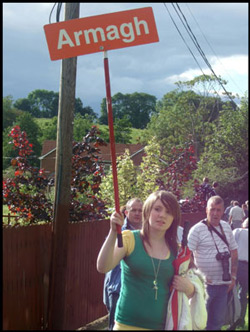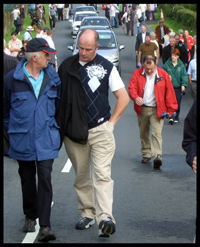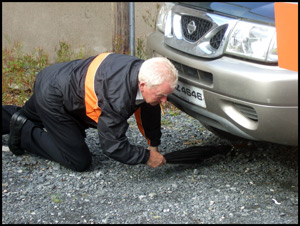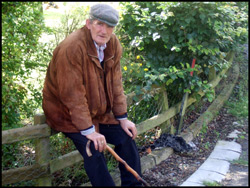By Laura McKean-Peraza

As onlookers stand on the longest bowling lane they've ever seen - a two-mile stretch of country road - the tension-filled crowd lines the road, shouting " Faugh a Ballach !" ("clear the road!") in Gaelic, the traditional language of Ireland.
This warning tells all of us, bowlers and observers alike, to watch out for the small cannonballs that will soon be flying through the air. The competitors prepare for their throws with windups similar to those used by American softball players. It's time for the ancient sport of Irish road bowling.
The crowds are spread along Cathedral and Battleford roads in Armagh to witness leading road bowlers - Sean O'Reilly from Ulster and Ger Fitzpatrick from Munster - battle it out for the All-Ireland Championship Finals.
As the fans wait anxiously for play to begin, stress levels are rising. The weather seems to change the odds and test the already placed bets, but play occurs rain or shine. They are especially eager now because Irish road bowling is just as competitive as Gaelic football or hurling. The All-Ireland championships happen every August, so this is the moment when tens of thousands of British pounds change hands and the bowlers are bound and determined to throw harder and faster than ever before.
How Road Bowling is Played
According to the rules of the Bol Chumann na hÉireann , the Irish Road Bowling Association, the road bowler throws a 28-ounce (1.75 pounds or 800 grams) cast-iron sphere (long ago, a stone) that looks like a small cannonball. Today's solid steel projectile is called a "bowl" in county Cork, but in county Armagh fans call it a "bullet" because renowned bowler Danny McFarland can throw it so fast and straight that it seems to fly like one.
As in golf, the road bowler tries to move the bullet or bowl from the start to the finish of a pre-determined course in as few drives or throws as possible. Today, the winner is the person who can complete a set course in as few throws as possible. (According to an earlier set of rules, however, the winner was the person who could throw the greatest distance using a set number of throws.) Unlike golf, though, the destination is not a particular spot or hole, but simply the other side of the finish line, which is one or two miles beyond the starting line.
The best courses are roads with some hills and irregularities in the paving to challenge the thrower. As in golf, precision in the drive or throw is crucial: the curl of the player's fingers around the bullet when released determines the curvature, speed, and distance of the throw, and the throws accumulate [as part of] the player's score. Portraits of famous road bowlers in oil by Armagh artist J.B. Vallely, on display all around the world, show the strength and endurance of the bowlers while the audience watches in suspense.
The Scene in Armagh

The roads are packed with road bowling enthusiasts who study each bullet thrower preparing to throw. In Armagh, the bullet thrower begins with a ten-foot running start while winding his or her entire arm and later releasing the bullet into the air. (Apparently in Cork, the thrower does not wind the arm during the run.) A single throw begins with an airborne flight at a speed of 70 or 80 miles per hour (as in baseball), and after the bullet reaches the ground there is an additional roll intended to cover as much distance as possible.
Bystanders have to be very aware of where they are at all times, because the heavy iron bullet is exactly the same color as the paving on the road and can be very hard to spot. To help players see more accurately, referees usually grab a patch of grass from the fields nearby and throw it onto the road so that the bullet thrower can have a contrasting visual goal in order to be precise when throwing. Onlookers must be able to observe carefully where each bullet lands. The referee marks the road with chalk where the bullet stops (even if it ends up off the road, the nearest point in the road is considered its landing spot). The player must then stand behind that mark for the next throw.
 |
Official marks the exact spot where the ball stopped |
Men and women compete in separate events, and throwers are also divided according to their age and degree of experience in the sport. Dennis McGarry, photographer for the Gaelic Athletic Association, says, "In any sport, experience means an awful lot!" Individuals compete against each other in the singles events, and they also play for regional teams that compete against each other as groups.
Since each bowling course is unique, each one has its own record holders. In 1955, for example, "Red" Joe McVeigh set a record of 22 throws on the Cathedral Road course in Armagh, and no one has ever beaten the record. His son Aidan McVeigh, now in his fifties, and Jarlath Devlin, head organizer of the Irish Road Bowling Association, both agree that "Joe McVeigh's record will never be beaten." At the All-Ireland Finals in August, female bullet throwers also competed to see who might come the closest to Red Joe McVeigh's 1955 record.
Road Bowling Through the Ages

Road bowling is technically difficult, yet it's an inexpensive sport requiring only a road that provides the course and the bullet itself. It has very ancient origins in the county of Armagh. The game may have begun as a contest among young men, possibly miners, in very ancient times, but it did not establish rules and regulations until the late 1600s when the soldiers of King William III of Orange, who ruled both Britain and Ireland, learned the local sport.
Today road bowling is a popular competitive sport where it is played, but the most vigorous competitions are in two Irish counties: Armagh and Cork. For example, when Ger Fitzgerald of Munster won the All-Ireland junior B title and prize of €8,200 at the finals, county Cork and other Munster fans lifted him up above the crowd, pictures flashed, and everyone cheered. Catching on in popularity, though, the game has migrated to the states of West Virginia, Massachusetts (particularly Boston), and New York, and it has also spread to Germany and the Netherlands in Europe.
The road bowling championship competitions are now held in Europe, America, and Ireland. Competition takes place during the day; and during the evenings of the three-day events, parties come alive to celebrate the day's victories while earning money for charities. Competitors and supporters enjoy this difficult and exhilarating sport, engaging in friendly banter and lots of betting. At the All-Ireland competition in Armagh this August, for example, betting is just as intense as the game. Cork thrower Aidan Murphy, who has been throwing for 15 years even though he is only 20 years old now, laughs as he calls out, "Don't gamble!" Even though the crowds fully acknowledge that betting is illegal, money changes hands as each round of play ends. Watching the competition is exciting and dangerous, since everyone needs to stay out of the way as the bullet flies and bounces along the course.
 "Get out of the road! You better win!" yells Noel Gould out the car window. Most of the throwers and fans speak to one another in Gaelic, including warnings to get out of the way. When they realize that fans do not understand the Gaelic warnings, they scream, "Watch yourself!" in English. And they do. The bullets fly and fans live to tell about it. So it goes on a day of Irish road bowling. "Get out of the road! You better win!" yells Noel Gould out the car window. Most of the throwers and fans speak to one another in Gaelic, including warnings to get out of the way. When they realize that fans do not understand the Gaelic warnings, they scream, "Watch yourself!" in English. And they do. The bullets fly and fans live to tell about it. So it goes on a day of Irish road bowling.
Online sources for Irish Road Bowling
Irish Road Bowling Association
http://www.irishroadbowling.ie
West Virginia Road Bowling
http://www.wvirishroadbowling.com/
"Irish Road Bowling" in Eclectic Collection for Cafe Press , at http://www.cafepress.com/eclecticon/
Noel Magnier, "The Sportof Irish Road Bowling," from Ireland's Own Magazine , available at http://www.terracetalkireland.com/articles/road-bowling.htm
Story by Laura McKean-Peraza
Photos by Alexandra Cavallo
Video by Megan McGovern
Website by Jane Koelle |

